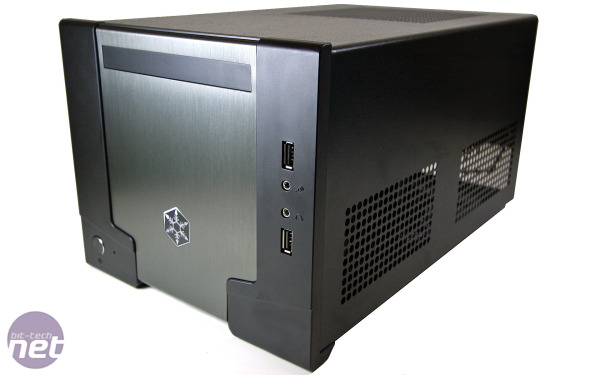
Results Continued
We should first mention that it was a very hot day when tested the Sugo SG07, with the room hitting 28°C. However, and as always, we express our thermal test results as delta Ts - the difference between the ambient temperature and the measured component. This explains why the Core i5-661 might seem to be running at 2°C at idle - actually it was idling at 30°C.We found that at stock speeds, the Core i5-661 with the SilverStone heatsink was perfectly stable and reasonably cool in the SG07. With the 180mm roof fan at low settings it was virtually inaudible, and even at high settings it still produced a tolerably very low noise, and also dropped the temperature by 10°C under load.
Overclocking the Core i5-661 to 4.4GHz with a 1.32V core voltage and roof fan set to high saw the temperatures increase dramatically. The CPU in our hot room actually nosed 90°C, but remained stable during our full-load stress test. We suspect the absence of a hot graphics card in this test setup helped the SG07 and NT06-E setup keep the CPU just cool enough.
After switching to the i5-750 and HD 5870 setup (which necessitated the removal of the roof fan), we saw hotter but still respectable cooling from the reasonably modest Titan Skalli CPU cooler and the SG07. The i5-750 was hotter than the i5-661, but then it is a quad-core CPU rather than a dual-core CPU with Hyper-Threading. Stressing just the CPU, we saw a respectable delta T of 44°C, while the GPU hit a delta T of 21°C. Stressing both the CPU and the GPU with Crysis saw the CPU temperature rise to a delta T of 37°C and GPU to a delta T of 50°C.
Running Crysis for a few hours made the whole system, including the case around the graphics card, get very hot to touch. This shows that heat is being successfully radiated by the metal of the case, and the temperatures are fine stability-wise.
We overclocked the i5-750 from 2.66GHz to 3.6GHz, with a 1.28V CPU vcore, but the CPU would hit 90°C within minutes of stressing, so this was too ambitious. The H55 chipset became incredibly hot when overclocking our i5-750 too, idling at around 68°C when we checked the BIOS. If you're planning on using the SG07 for an overclocked, powerful gaming rig then you'll need to beef up the cooling.
Value
SilverStone claims that the SG07 will retail for about 160 Euros, or 170 Euros with the case window option, although a German retailer has already listed it at 199 Euros. That's still not a terrible price for a sleek mini-ITA case with a reasonably powerful 600W PSU inside. We'd definitely want a pair of right-angled SATA cables in the box, if only for convenience though.As far as other mini-ITX cases worth looking for go, Fractal Design's Array R2 shouldn't be much different in price, and although the Lian Li Q08 is slightly cheaper, it's also notably larger and doesn't come with a power supply.
Conclusion
SilverStone has got much of the SG07's design spot on - the pre-installed PSU is hefty enough for the long, powerful graphics card that can be fitted in the case, and the large roof fan is quiet and keeps reasonably fast mini-ITX components cool. The case looks neat and tidy, and it's not as bulky as other gamer-friendly mini-ITX cases either.However, SilverStone should borrow Shuttle's book on 'Cable Routing for XPCs' to really make the SG07 easy to work with. We expected a degree of compromise and difficulty given the small form factor, but the build involves too much forcing cables out of the way and stuffing them in little nooks and gaps to make the building experience stress-free. Cable management is essential in a small case, and the SG07 lacks it. It also misses the attention to detail in other areas: the non-detachable fan, and having to unscrew the power socket to install a graphics card are both significant oversights.
Still, as you're likely to only build the case once (or, at the most, once a year) these drawbacks don't outweigh the benefits of being able to run a fast dual-core CPU and a hefty graphics card in such a small system. The casing might get hot, but that's true of even full tower cases around the graphics card area. The Sugo SG07 is therefore a solid purchase for a tiny gaming PC.
- Performance
- x
- x
- x
- x
- x
- x
- x
- -
- -
- -
- 7/10
- Features
- x
- x
- x
- x
- x
- x
- x
- x
- -
- -
- 8/10
- Build Quality
- x
- x
- x
- x
- x
- x
- x
- -
- -
- -
- 7/10
- Ease of Use
- x
- x
- x
- x
- x
- -
- -
- -
- -
- -
- 5/10
- Value
- x
- x
- x
- x
- x
- x
- x
- -
- -
- -
- 7/10
- Overall
- x
- x
- x
- x
- x
- x
- x
- -
- -
- -
- 7/10

MSI MPG Velox 100R Chassis Review
October 14 2021 | 15:04









Want to comment? Please log in.